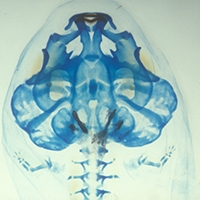Journal Articles and Book Chapters: Present - 2010
, 2020. New Species of Leaf-litter Toad of the Rhinella margaritifera Species Group (Anura: Bufonidae) from Amazonia. Copeia , 108 (4) , pp. 967-986.
, 2020. A new species of Dendropsophus (Anura, Hylidae) from southwestern Amazonia with a green bilobate vocal sac. ZooKeys , 942 , pp. 77.Abstract
, 2020. Ontogeny of the anuran urostyle and the developmental context of the evolutionary novelty. PNAS , 117 (6) , pp. 3034-3044.
, 2020. Development and evolution of the tetrapod skull-neck boundary. Biological Reviews , 95 , pp. 573-591.Abstract
, 2019. Diversification of shrub frogs (Rhacophoridae, Pseudophilautus) in Sri Lanka– Timing and geographic context. Molecular Phylogenetics and Evolution , Volume 132 (March 2019) , pp. 14-24. Publisher's Version
, 2019. Evolutionary Conservation of ThyroidHormone Receptor and DeiodinaseExpression Dynamics in ovo in aDirect-Developing Frog,Eleutherodactylus coqui. Frontiers in Endocrinology , 10 (article 307). Publisher's Version
, 2018. Early limb patterning in the direct-developing salamanderPlethodon cinereus revealed by sox9 and col2a1. Evolution & Development , 20 (3-4) , pp. 100-107. Publisher's Version
, 2015. Patterns of reproductive-mode evolution in Old World tree frogs (Anura, Rhacophoridae). Zoologica Scripta , doi:10.1111/zsc.12121.
, 2015. YesWorkflow: A User-Oriented, Language-Independent Tool for Recovering Workflow Information from Scripts. International Journal for Digital Curation , 10 , pp. 298-313.
, 2015. Dual embryonic origin and patterning of the pharyngeal skeleton in the axolotl (Ambystoma mexicanum). Evolution & Development , 17 , pp. 175-184.
, 2015. Is heterochrony still an effective paradigm for contemporary studies of evo-devo?. In Conceptual Change in Biology: Scientific and Philosophical Perspectives on Evolution and Development. Boston Studies in the Philosophy and History of Science. Berlin. Berlin: Springer-Verlag, pp. 97-110.
, 2015. Development of neuroendocrine components of the thyroid axis in the direct-devoloping frog Eleutherodactylus coqui: formation of the median eminence and the onset of pituitary TSH production. Gen. Comp. Endocrinol. , 214 , pp. 62-67.
, 2014. Toward automated design, analysis, and optimization of declarative curation workflows. Internat. J. Dig. Curat. , 9 , pp. 111-122.
, 2014. Natural History Collections as Emerging Resources for InnovativeEducation. Bioscience , 64 , pp. 725-734.Abstract
